
Dear Bird Folks,
I never thought I’d have to ask this question, but where are all the house finches? We used to have tons and now we have very few.
Floyd, Orleans
Hey Floyd,
I never thought I would have to answer this question either. There was a time when asking what happened to all of the house finches would be like asking why telemarketers don’t call anymore. House finches were so common in the early 90’s, that customers complained that they were keeping away other feeder birds. People were constantly upset because finches were building nests in all of their hanging plants. Several feeder companies even produced house finch proof feeders.
Then suddenly all of the complaining stopped and now it’s been years since I’ve had anyone whine about house finches. Were have they gone and what caused the decline? Were they killed in a storm? Did they just migrate away and not come back? Oh yeah, I’m supposed to answer questions, not ask them.
Here is the deal with house finches. Up until 1940, house finches were a bird that only lived on the U.S. West Coast. They aren’t even from around here. Then some creeps trapped a bunch and brought them to New York to be sold as “Hollywood Finches.” But 1940 was also the same year that it became illegal to sell native songbirds as pets. So the creeps just let the birds go in the wilds of Long Island. Now on the loose in a new area, the house finch population exploded. In a few short decades they became very common birds along the entire eastern U.S. from southern Canada to Florida. In 50 years the finch population went from zero to 300 million. In 1990 we had almost as many house finches as we did Starbucks coffee shops.
The down side of such a quick population explosion is that all of these millions of eastern birds are genetically inferior to the West Coast finches. Most all of the house finches in the eastern part of the U.S. came from the original 30 pairs of released birds. These finches are basically inbred. Inbreeding almost always leads to problems. (Just ask any of those freaks at a Star Trek convention.) About 10 years ago house finches developed a new form of avian conjunctivitis. This eye ailment causes the bird’s eyes to crust over and, if untreated, the bird will most likely go blind and starve. In the first three years of its appearance, conjunctivitis dropped the house finch population from 300 million to 180 million, and the population continued to decline.
Now before you go running away from your bird feeder, screaming with a towel soaked in Bactine wrapped around your eyes, you should know that this disease is not contagious to humans. So if you are reading this and are human, you are perfectly safe from this affliction. And even though 60 percent of the house finch population has been wiped out by this disease, very few other bird species have been affected.
Only about 2 percent of the goldfinch population has contracted conjunctivitis, for they are native to our area and have evolved from a much stronger gene pool.
The only thing we can do to stop the spread of conjunctivitis is to keep our feeders clean. Soaking your feeder in a mild 10 percent bleach solution will kill the bacteria. If you see an infected bird (swollen or crusted eyes), take your feeders in to prevent the sick bird from spreading the disease to other feeder birds.
Don’t worry Floyd, the house finch population should stabilize. In recent years the conjunctivitis epidemic seems to be abating and has become less of a threat to the house finch population. As a whole, the finches hould be fine, but rapid growth of any species usually leads to annoyances and problems for them and everything around them. Hear that Starbucks?